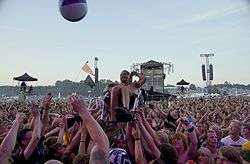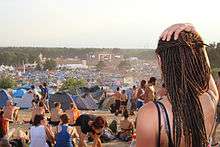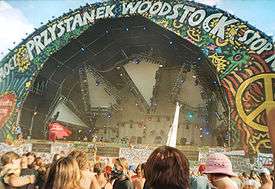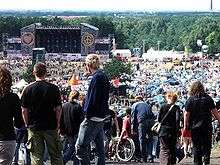Woodstock Festival (Poland)
| Woodstock Festival | |
|---|---|
  | |
| Genre | Rock, punk rock, reggae, rapcore, folk music, heavy metal, electronic music . |
| Dates | The end of July/beginning of August |
| Location(s) | Kostrzyn nad Odrą (Kustrin), Poland |
| Years active | 1995–present |
| Attendance | 750,000 (2014) |
| Website | |
|
www | |
Woodstock Festival Poland (Polish: Przystanek Woodstock; "Woodstock Station"; English-language materials often refer simply to the Woodstock Festival) is an annual ticket-free rock music festival in Poland, inspired by and named for the Woodstock Festival, that has taken place since 1995. In 2009 Woodstock Festival Poland gathered above 400,000 people,[1] in 2011 the attendance was above 700,000,[2] in 2012 attendance was about 550,000 people,[3] in 2013 attendance was about 500,000[4] and in 2014 attendance was about 750,000 (record).[5] The average attendance for the past four years is 625,000 people. Since the 11th festival its organizers have called Przystanek Woodstock "the biggest open-air festival in Europe".
Background

The festival's motto is "Love, Friendship, and Music". It is organized by the Great Orchestra of Christmas Charity NGO as a way of thanking its volunteers. Generally a weekend-long event, its two stages are in continuous use from early afternoon to dawn, featuring performances by around 30 bands every year. Many Polish bands have made several appearances, including IRA, Myslovitz, Dżem, Acid Drinkers, Lessdress and 2TM2,3. Foreign bands are also invited every year - Sabaton (band), The Stranglers, Papa Roach, The Prodigy, Guano Apes, Kontrust, Clawfinger, Nigel Kennedy, Gentleman, Korpiklaani to name but a few appearances. A battle of the bands takes place prior to the festival, and the winners are given a chance to perform. The main musical theme is generally rock, but genres represented run almost a full gamut from folk through experimental to metal. Recent years has also seen reggae, electronic music and even classical music represented. The name Przystanek Woodstock - "Woodstock Station" refers to peace and friendship symbolized by the Woodstock Festival and the TV series Northern Exposure, aired as Przystanek Alaska (Alaska Station), immensely popular in Poland at that time.
Along with the concerts on two stages there are many other events organized during the festival. The Academy Of The Finest Arts is a place where young people meet with well-known politicians like Lech Wałęsa, a former Polish president, artists, journalists, musicians, actors and religious leaders including Kesang Takla - the Dalai Lama's Northern European representative. In 2009, for the 40th anniversary of the original Woodstock Festival from 1969, Michael Lang, the organizer of the American event, was invited. The Hare Krishna movement also commonly shows up to organize an Indian food cafeteria, yoga classes, meditation exercises or meetings with their gurus.
History




The first Woodstock Festival Poland took place on 15–16 July 1995, in the town of Czymanowo (near Gnewin), located near the Żarnowieckie Lake. The performers included Carrantouhill, Skankan, Żuki, Myslovitz, Ira, and Urszula. During the festival no alcohol was sold, which was similar to the Jarocin festivals.
The second festival was held in Szczecin-Dąbie, Szczecin in 1996. This time the first Woodstock's "prohibition law" was partially lifted and beer was sold.
The third festival took place the next year, on 16–17 August in the town of Żary, which became the setting of the Przystanek Woodstock festivals till 2003. Initially the festival was planned to be held in July, but because of the 1997 flood, which affected much of Poland, the festival was postponed until August.
The 1998 Woodstock Festival Poland featured the performances of nearly 50 bands. The band list included Closterkeller, Akurat, Oddział Zamknięty, Kobranocka, and Acid Drinkers. Almost 150,000 people attended the festival.
The 1999 Woodstock was held on 6–8 August. This time the attendance record was broken. The audience reached almost 200,000 people.
The 2000 festival was planned to be held in Lębork, but due to permission uncertainties, and protest of local committees (Komitet obrony Moralności - The Committee for the Defense of Morality) it had to be cancelled. Nevertheless, over 1000 people showed up and organized an unauthorized "rock'n'roll picnic" without any professional music bands. This happening was later referred to as the "Dziki Przystanek" ("The Wild Station").
In 2001 Żary was again the setting for the festival. The 2002 Woodstock was significant, because it was filmed, and the footage was used to produce "Przystanek Woodstock. Najgłośniejszy Film Polski" ("The Woodstock Station. The Loudest Film In Poland"), a concert film, which was screened in movie theatres across the country the following year, and also took part in a number of international film festivals.
The 2003 Woodstock was the last one held in the town of Żary. Because of controversy surrounding some incidents during the festival, that Jerzy Owsiak was part of, it was decided that Żary would no longer be a setting for the concerts.
Since 2004, the festival has taken place in the town of Kostrzyn nad Odrą.
In 2011 was a bigger festival with bands like The Prodigy and Helloween. Police had concerns of crowd numbers for The Prodigy performance, with fans swelling over a million in the area to see them play.
See also
References
External links
| Wikimedia Commons has media related to Przystanek Woodstock. |
Coordinates: 52°36′41″N 14°40′05″E / 52.61139°N 14.66806°E